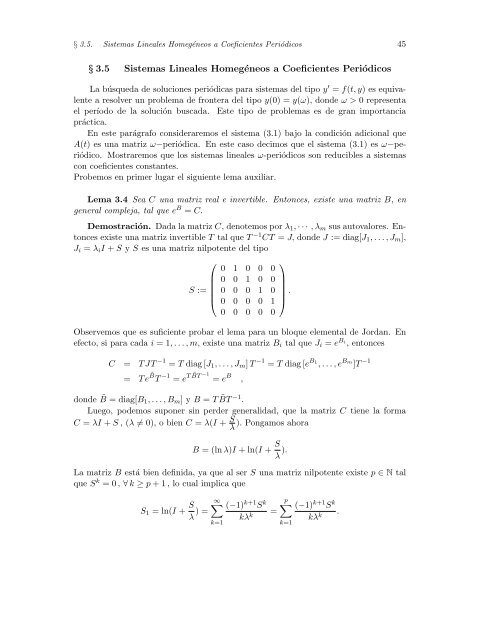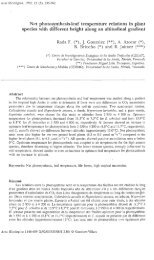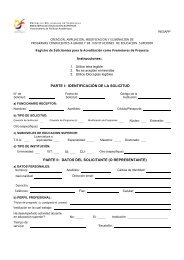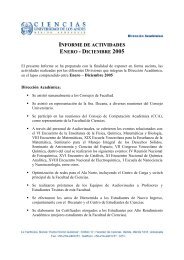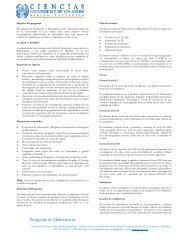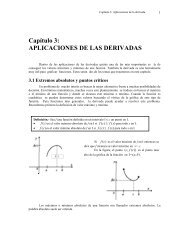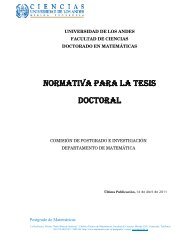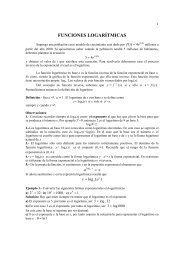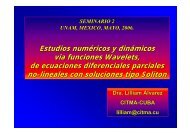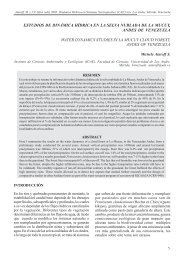Ecuaciones Diferenciales Ordinarias - Facultad de Ciencias
Ecuaciones Diferenciales Ordinarias - Facultad de Ciencias
Ecuaciones Diferenciales Ordinarias - Facultad de Ciencias
You also want an ePaper? Increase the reach of your titles
YUMPU automatically turns print PDFs into web optimized ePapers that Google loves.
§ 3.5. Sistemas Lineales Homegéneos a Coeficientes Periódicos 45<br />
§ 3.5 Sistemas Lineales Homegéneos a Coeficientes Periódicos<br />
La búsqueda <strong>de</strong> soluciones periódicas para sistemas <strong>de</strong>l tipo y ′ = f(t, y) es equivalente<br />
a resolver un problema <strong>de</strong> frontera <strong>de</strong>l tipo y(0) = y(ω), don<strong>de</strong> ω > 0 representa<br />
el período <strong>de</strong> la solución buscada. Este tipo <strong>de</strong> problemas es <strong>de</strong> gran importancia<br />
práctica.<br />
En este parágrafo consi<strong>de</strong>raremos el sistema (3.1) bajo la condición adicional que<br />
A(t) es una matriz ω−periódica. En este caso <strong>de</strong>cimos que el sistema (3.1) es ω−periódico.<br />
Mostraremos que los sistemas lineales ω-periódicos son reducibles a sistemas<br />
con coeficientes constantes.<br />
Probemos en primer lugar el siguiente lema auxiliar.<br />
Lema 3.4 Sea C una matriz real e invertible. Entonces, existe una matriz B, en<br />
general compleja, tal que e B = C.<br />
Demostración. Dada la matriz C, <strong>de</strong>notemos por λ 1 , · · · , λ m sus autovalores. Entonces<br />
existe una matriz invertible T tal que T −1 CT = J, don<strong>de</strong> J := diag[J 1 , . . .,J m ],<br />
J i = λ i I + S y S es una matriz nilpotente <strong>de</strong>l tipo<br />
⎛<br />
S :=<br />
⎜<br />
⎝<br />
0 1 0 0 0<br />
0 0 1 0 0<br />
0 0 0 1 0<br />
0 0 0 0 1<br />
0 0 0 0 0<br />
Observemos que es suficiente probar el lema para un bloque elemental <strong>de</strong> Jordan. En<br />
efecto, si para cada i = 1, . . .,m, existe una matriz B i tal que J i = e B i<br />
, entonces<br />
⎞<br />
⎟<br />
⎠ .<br />
C = TJT −1 = T diag [J 1 , . . .,J m ] T −1 = T diag [e B 1<br />
, . . .,e Bm ]T −1<br />
= Te ˜BT −1 = e T ˜BT −1 = e B ,<br />
don<strong>de</strong> ˜B = diag[B 1 , . . .,B m ] y B = T ˜BT −1 .<br />
Luego, po<strong>de</strong>mos suponer sin per<strong>de</strong>r generalidad, que la matriz C tiene la forma<br />
C = λI + S , (λ ≠ 0), o bien C = λ(I + S ). Pongamos ahora<br />
λ<br />
B = (lnλ)I + ln(I + S λ ).<br />
La matriz B está bien <strong>de</strong>finida, ya que al ser S una matriz nilpotente existe p ∈ N tal<br />
que S k = 0, ∀k ≥ p + 1, lo cual implica que<br />
S 1 = ln(I + S λ ) = ∞ ∑<br />
k=1<br />
(−1) k+1 S k<br />
kλ k =<br />
p∑<br />
k=1<br />
(−1) k+1 S k<br />
kλ k .


